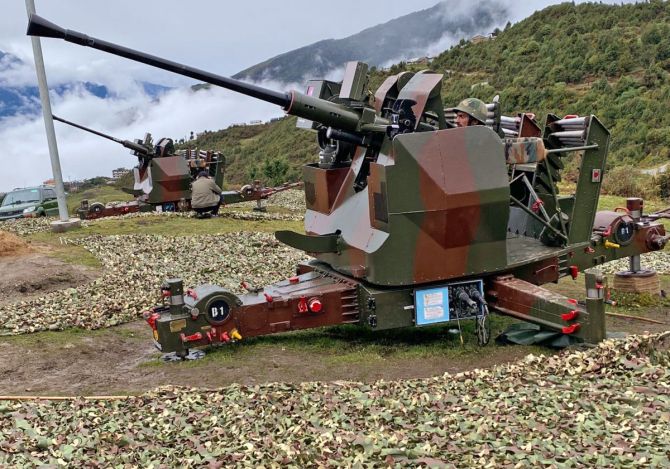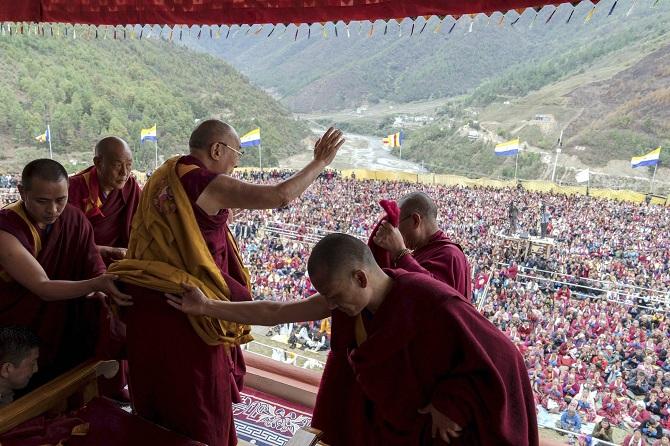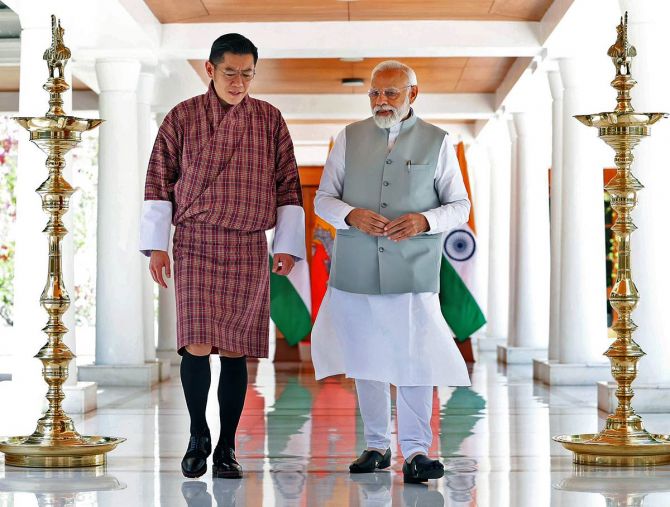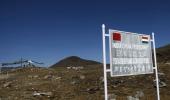How does blatantly claiming Indian territory help to maintain 'peace in border regions', is a mystery that only China can explain, notes Claude Arpi.

China has done it again.
China's ministry of civil affairs has standardised the names of 11 places in Zangnan, a new name for Southern Tibet -- 'Zangnan' is an abbreviation of (Xi)Zang = Tibet, and 'Nan' (south in Mandarin).
China has recently started using this term for the Indian state of Arunachal Pradesh.
For Beijing, the so-called Zangnan is itself part of the Xizang Autonomous Region, Xizang being the Chinese name for 'Tibet'.
Is it not confusing this name changing? It is probably Beijing's main purpose.
A chart in Chinese characters, Tibetan and pinyin transliteration of the 11 new names was released 'in accordance with regulations on geographical names issued by the State Council' -- China's cabinet.
It is not the first time that China has changed names, but one can ask what is Beijing's ultimate purpose?
We shall come to it later, but it is clear that it could be related to the visit of Jigme Khesar Namgyel Wangchuck, the fifth king of Bhutan, in Delhi to clarify the position about Bhutan's negotiations with China, and about the existence of a 'border deal' with China.
In this perspective, the fact that a map accompanying the article (in Chinese) about the renaming in Arunachal shows Sakteng, an area in the Trashigang district of Eastern Bhutan, previously claimed by China, as part of Bhutan, is worth noting.

Renaming places
Renaming places is not new. It has been done by all coloniSers; India still remembers the British days.
China has done it in a more systematic manner. After it invaded Tibet in 1950-1951, Shigaste became Rikaze or Xigatse, Sakya was Sa'gya, Metok, north of Arunachal's Upper Siang district, Mutao or Medog.
Apart from the cases of pure pin yinsation like the ones just mentioned, in many cases, names have been completely changed.
Ngari province is now called Ali Prefecture (perhaps due to faulty Chinese pronunciation which can't pronounce 'Ng' and 'r); Kyirong at the border with Nepal is now Jilong and worse, Barahoti in today's Uttarakhand is called Wuje, while Demchok in Ladakh is termed Parigas.
First Renaming in Arunachal Pradesh
In 2017, the Chinese cabinet announced the 'standardised names' for six places in Arunachal Pradesh.
At that time, it looked like a childish reaction to the Dalai Lama's visit to the state a month earlier.
The Chinese media then admitted that Beijing's objective was to reaffirm China's claim over Arunachal, 'South Tibet' (now Zangnan) for the Chinese.
The official names of the six places (transcribed in the Roman alphabet) were Wo'gyainling, Mila Ri, Qoidengarbo Ri, Mainquka, Bumo La and Namkapub Ri. Let us have a look at a couple of them.
Wo'gyainling is the new spelling for Urgyeling, the birthplace of Tsangyang Gyaltso, the sixth Dalai Lama, a few kilometres south of Tawang town.
One understands the political reasons why China would be so attached to the place.
Beijing was/is not ready to accept that a Dalai Lama could be born outside Tibet (China for Beijing).
Another place was Qoidengarbo Ri, for 'Chorten Karpo' or 'White Stupa'.
It refers to Gorsam Chorten, the only large white stupa in the area (and the largest in Arunachal).
It is not far from Zimithang, the tactical HQ of the 4 Infantry Division during the 1962 war.
The name 'Ri' or ridge in Tibetan may refer to one of the ridges around the stupa.
Second 'Renaming': 15 Places in 2021

In 2021, 15 places were given new names with precise coordinates; eight were residential areas/settlements, four were peaks/mountains, two were rivers and one is a mountain pass (Sela).
Contrary to what the Indian media wrongly mentioned at that time, the names are not 'invented' names; they were transcriptions of the old Tibetan names for these 15 areas.
This is far more serious than 'invented names'; by 'proving' that these places had Tibetan names, China can come to the easy conclusion that they have been Tibetan places ... and therefore Chinese.
The argument is tenuous, as it is often the case, but it does not stop China from using it.
It gives a clear message to India: Whatever has been Tibetan (or even had a Tibetan name) belongs to China.
One day, places in Ladakh, Sikkim or Kinnaur ... and Bhutan will thus be claimed.
Eleven New Names
On April 2, 2023, a communique announcing a third renaming, was released by the Chinese ministry of civil affairs; it stated that it was 'a legitimate move and China's sovereign right to standardize the geographical names'.
It included two residential areas/settlements, five mountain peaks, two rivers and two other areas.
It asserted that 'China's move to standardize the names in Zangnan completely falls within China's sovereignty'.
Zhang Yongpan, a research fellow at the Institute of Chinese Borderland Studies of the Chinese Academy of Social Sciences, is quoted by The Global Times as saying: 'It is more meaningful to safeguard national sovereignty, maintain peace in border regions and manage border-related matters at the legal level.'
How does blatantly claiming Indian territory help to maintain 'peace in border regions', is a mystery that only China can explain.
Looking at the list of 11 places, most of them are unknown or remote areas, however three are close to the Line of Actual Control -- namely Pangchen, a village in the Zimithang Circle which has a historic background during the 1962 border war with China; then Chakmutse Gangri, near Taksing in Upper Subansiri and finally Goyul Thang, a tiny flat ground near Kaho on the river Lohit.
Except for Pangchen village, these places are small and unknown even to most Arunachalis.

Why this Futile Exercise Now?
China knows that the Indian media will jump on this type of 'scoop'.
The PTI correspondent in Beijing was the first to quote the state council's latest notification and spread the news.
This is fine; one can consider it as part of the information warfare against India. Delhi should just be aware of it.
More worrying is the map mentioned earlier. Does it signal that Sakteng has now been accepted as part of Bhutan by China and that Beijing does not claim the place anymore?
In itself it is good, but if it is part of the 'package deal' between China and Bhutan mentioned in the Indian press, it has other implications.
Were the declarations of the Bhutanese prime minister, which probably triggered the Bhutanese king's visit to Delhi, meaning that a deal has been arrived at?
In this case, India's interests are at stake, especially as far as the Siliguri Corridor is concerned. Is such a deal is in the pipeline?
A Small Anecdote
Several years ago, a senior officer of the Royal Bhutanese Army was having talks with a Chinese delegation which started arguing that 'la' was a Chinese word (it means 'pass' in Tibetan and Bhutanese, but not in Chinese).
Even after the Bhutanese negotiators told their Chinese counterparts that it was not a Chinese name, the latter continued to insist.
It is then that the smart Bhutanese official interrupted the Chinese argument and asked: 'What about Patia-la? Is it a Chinese place?'
The Chinese were so much taken by surprise that they kept quiet ... at least for some time.
This anecdote came to mind when I read that Beijing had released the third batch of 'new' names for places in Arunachal Pradesh.
In the meantime, India should systematically only use the traditional English transliteration of Tibetan places -- Tsona (not Cona), Shigatse (not Xigaze or Rigaze) or Lhuntse (not Longzi); tens of thousands of names of Tibetans towns/villages have thus been changed by China.
After all, as the chief minister of Arunachal Pradesh often says, 'My State has no border with China, only with Tibet.'










